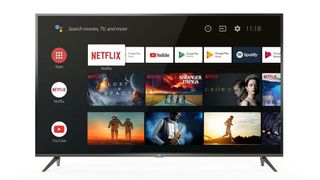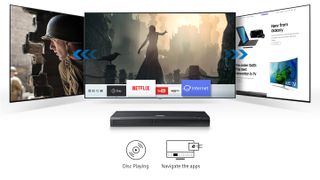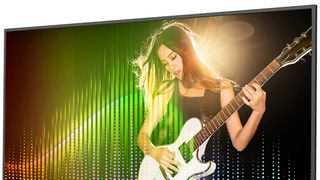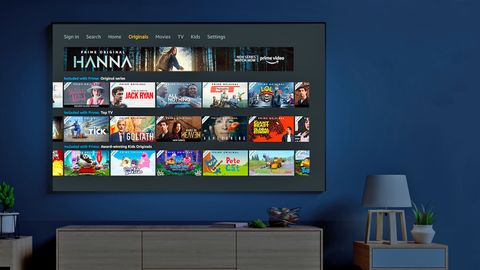TechRadar Verdict
While the TCL EP658 is quite accomplished where 4K content is concerned, it can struggle with low-res content – while its ability to sync audio and video is surprisingly poor.
Pros
- +
Great with 4K content
- +
Android OS
- +
Worthwhile control app
Cons
- -
Scrappy upscaling
- -
Audio/video syncing issues
Why you can trust TechRadar
TCL has been something of an underground success in the past few decades – eventually becoming the second-largest consumer electronics company on the planet. The United States is well aware of TCL – and having dipped a very successful toe into Germany, the company now intends to make its mark in the rest of Europe too.
TCL’s strategy in this regard is pretty straightforward: deliver several TV ranges, and make each one appreciably less expensive than the competition while matching them in terms of specification. Then watch consumers’ wariness crumble in the face of the TCL performance/cost ratio.
That’s the theory, anyhow. In practice – at least as far as this 43EP658 is concerned – it’s not quite so simple. With a £329 price tag, the TCL 43EP658 is astonishingly good value, but – as you'll find below – it can't quite deliver on all of its promises.
Design
Whenever a manufacturer wants to hit a particularly aggressive price-point with a product, design development is quite often the first thing for the chop. It makes sense: most viewers (especially at this price range) are after great picture quality and sound that doesn’t set their teeth on edge. Anything else is a bonus, and will have to be paid for.
So it’s no surprise, and no disappointment, to find that the 43EP658 chooses function over fashion. Its top, left and right bezels are reasonably slim, and nicely finished in glossy black plastic. The broader bezel across the bottom of the screen is in silver-painted plastic, and in its centre has both some discreet ‘TCL’ branding and a combined IR receiver/LED for receiving and confirming instructions from the remote control.
The remote is just as functional a device as the TV it controls. It’s a bit too long, feels undeniably cheap in the hand, and has had its buttons arranged seemingly at random. It’s just as well TCL also has its T-Cast control app, which is one of the more thorough and stable of its type – and offers a good replacement for the remote.

There’s a bit more silver-painted plastic forming the 658’s simple feet. These are far enough apart to make positioning a soundbar between them pretty easy, but this also means the TV will need quite a wide surface to stand on if it’s not being wall-mounted.
Wall-mounters will be pleased to hear the TCL accepts a bog-standard VESA bracket, but less pleased to hear that the EP658 is 78mm at its deepest point. That’s beyond doubt an old-school measurement, and it makes the screen look like it might have been up on the wall since 2010.
A lot of this depth is down to the TCL’s direct LED backlighting, but the company doesn’t seem to have made much of an effort to minimise it. A few physical inputs, including two HDMI 2.0 ports (one with HDMI ARC), are joined by a USB input, aerial posts for satellite and terrestrial TV tuners, an Ethernet input, a 3.5mm socket for use with a composite video adapter, and a digital optical output).
Design TL;DR Overall, an inoffensive looker, though the depth of the chassis may be offensive to some

Smart TV: Android TV
Resolution: 3840 x 2160
HDR: HLG, HDR10
HDMI: 2 x 2.0
USB: 1
Ethernet: Yes
Wi-Fi: Yes
Bluetooth: Yes
OS: Android
Tuners: Satellite, terrestrial
Dimensions: 572 x 970 x 78mm
Weight: 7.8kg
The 43EP658’s quad-core processor drives an Android 9.0 operating system and Android TV smart TV interface – which is, let’s be honest, a better and more sophisticated specification than the TCL’s price might suggest is possible.
As usual, Android TV is a combination of the outstanding and the mildly infuriating. On the plus side, it works in tandem with Google Home to serve up access to pretty much every streaming and catch-up service worthy of the description. The layout is reassuringly familiar from any number of more expensive TVs, too. But, as usual, the interface occupies the entirety of the screen in an unashamedly imposing manner; really, it’s a bit like being shouted at. We can put up with this, though, given how straightforward navigating the interface is.
As well as the so-so remote control and the really-quite-good T-Cast control app, the 43EP658 is ready to be voice-controlled – being compatible with both Alexa and Google Assistant devices. The voice assistant will only carry you so far, though, as the TCL’s brief set-up menus must be navigated manually.
Smart TV TL;DR Android OS + Android TV + Google Home = interaction satisfaction

HD/SDR performance
There doesn’t seem much point in beating about the bush here, so let’s not bother. The TCL 43EP658 is not a very accomplished upscaler of standard- or high-definition content, and as a consequence isn’t all that pleasant to watch.
In some ways, it’s understandable. After all, few are the 4K TVs at any price that can make a decades-old episode of The Sweeney (standard definition) on ITV4 look anything other than antique. And, sure enough, this daytime-TV schedule filler is rendered soft and indistinct by the TCL: the picture is low on detail, and high on video noise, especially in darker areas of the screen or when displaying complicated patterns and textures. Edges are jagged more often than they’re smooth, and the TCL 32EP658 is badly flustered by motion too.
But not only does stepping up in quality to HD once or twice (first with a DVD of Zoolander, and then with a Netflix stream of Big Night followed by a 1080p Blu-ray disc of The Prestige) fail to really improve matters all that much, it also throws up some other shortcomings.
Oh, there’s no doubt detail levels improve along with the increase in resolution of the source, and edges are far better-behaved. But there’s still more picture noise, and less insight into black tones, than is ideal. And the 21:9 content, with its black letterbox bars top and bottom of the screen, reveals backlight beam from each corner of the screen.
One of the TCL’s picture presets (along with the usual ‘standard’, ‘movie’, ‘sports’ and so on) is ‘smart HDR’. This attempts to inject a little HDR-style luminance and colour volume into SDR material, but in practice it simply ramps up the brightness of the screen until the TCL’s 300-or-so nits bleach white tones completely free of detail. In extreme circumstances – when the on-screen image is predominantly bright white in the first place, for example – there’s a small, but undeniable, strobing or flickering of the brightest areas.
Some quite fundamental audio/video syncing problems manifest themselves, too. The TCL doesn’t have any problems keeping the pictures and the sound of an off-air broadcast synchronised, but content delivered either by disc or by streaming service can fall out of harmony. If your disc player, like the Samsung UBD-M9500 used for the majority of this test, has some adjustment in terms of sound delay this trait can be overcome. But for streamed content, all the viewer can do is watch the mouths move and wait for the dialogue to come.
HD/SDR performance TL;DR Ragged upscaling and some audio/video syncing problems make for a suboptimal experience

4K/HDR performance
The TCL comes quite strongly into its own when given some native 4K content to deal with. A UHD disc of The World’s End enjoys a nuanced and wide-ranging colour palette, fine detail levels and some very worthwhile insight into dark or black tones – and those blacks are pretty deep and convincing, too.
The EP658 is way more assured in every other aspect of picture-making here than with sub-4K material. Edges are drawn smoothly and confidently, and motion-tracking is equally convincing. There’s good depth of field to images, and picture noise is suppressed really well – even in scenes of uniform colour and depth. Contrasts are pretty strong, and the TCL manages to retain detail in both dark and bright tones even if they’re occupying the same scene.
It’s slightly strange to realise that the same screen that was so flummoxed by 720 x 480 DVD content can be so calm and composed when given all the information necessary to fill its native resolution.
The World’s End is an HDR10+ master, with all the theoretical advantages the dynamic metadata standard offers. But the TCL’s HDR compatibility extends only as far as HLG and HDR10. So the occasional bit of BBC iPlayer 4K content (Seven Worlds, One Planet for instance) is maximised by the 43EP658 – at least as far as that’s possible with a 300-nit peak brightness. But it can only apply HDR10 static metadata to the HDR10+ disc, and as a consequence some of the luminosity and detail lurking in the dingy interiors of the film’s numerous pubs is left behind.
4K/HDR performance TL;DR Capable of detailed and quite convincing images (within its 300-nit, HDR10 confines)

Sound
The TCL is Dolby Audio-certified, and uses a couple of downward-firing full-range drivers, powered by a total of 16 watts, to deliver sound. Like the vast majority of flatscreen TVs (not only the most affordable ones), the EP658 sounds fairly hard, and flat, and lacks any meaningful dynamic expression. Having said that, though, the audio balance is quite well judged, with a slight emphasis on the midrange to make sure dialogue projects clearly.
There’s a genuine hint of weight to the low frequencies (which is good) and some treble spikiness waiting to surprise those who ramp up the volume (which is not so good). While the actual quality of the TCL’s sound is nothing like as aggravating as the way it falls out of sync with the accompanying images, a modestly-priced soundbar will bring across-the-board audio improvements.
Sound TL;DR Not as unpleasant as some alternative TVs, but still not really up to much
Other panels to ponder
If you’re looking to make your money go absolutely as far as possible, you shouldn’t really be considering any other 2020 TVs. Slightly older models represent brilliant value, thanks to the TV industry’s insistence on renewing its model line-ups every twelve months – and it’s possible to spend very similar money to this on a significantly better product.
Take Samsung’s UE43RU7470, for example. A great 2019 TV remains a great TV even a whole year later – and the RU7470 is a great watch with 4K content and a much better upscaler than the TCL. It's also packing HDR10+ and doesn’t have any audio/video syncing issues – and is yours for very similar money to the EP658. (It is a UK only set, but the RU7100 will offer a similar product in the US.)
If you want as many whistles and bells as this sort of outlay can buy, check out the Philips 43PUS6704. It’s packing HDR10+ and Dolby Vision support, Dolby Atmos compatibility, and even Philips’ unique Ambilight technology too. You may have to cast your net quite wide to secure one – but it’s time (and money) well spent.

Verdict
The TCL 43EP658 is, ultimately, a false economy. Its on-paper specification is intriguing, and there are a couple of aspects of its performance that are authentically enjoyable. But its flaws – as an upscaler, and particularly where it comes to keeping pictures and sound in sync – scupper its chances.
- Check out the best cheap 4K TVs available today
Simon Lucas is a senior editorial professional with deep experience of print/digital publishing and the consumer electronics landscape. Based in Brighton, Simon worked at TechRadar's sister site What HiFi? for a number of years, as both a features editor and a digital editor, before embarking on a career in freelance consultancy, content creation, and journalism for some of the biggest brands and publications in the world.
With enormous expertise in all things home entertainment, Simon reviews everything from turntables to soundbars for TechRadar, and also likes to dip his toes into longform features and buying guides. His bylines include GQ, The Guardian, Hi-Fi+, Metro, The Observer, Pocket Lint, Shortlist, Stuff T3, Tom's Guide, Trusted Reviews, and more.


